The Dessau scandal with its political undertones was reported in Pravda,1 the main mass party newspaper of the USSR. The arrival of this famous architect who had so recently fallen prey to politically motivated persecution, provoked a certain degree of excitement. At the beginning of November, Meyer and his former student Béla Scheffler, leader of the Bauhaus communist cell, gave several talks at the Higher Institute for Architecture and Building (VASI: successor of the VKhUTEMAS/Vkhutein2), attended by thousands of curious listeners. These gatherings were accompanied by a small pop-up exhibition, das zerstörte Bauhaus, which probably lasted around a week. Existing photographic documentation show that the exhibition included textile samples, images of the Trade Union school, as well as pictures used by Meyer in the brochure “Junge Menschen kommt ans Bauhaus” (1929), a programmatic text advertising the Meyer Bauhaus.3 The exhibition also included a watercolor and a photograph by Fritz Kuhr, while an Alexander Schawinski poster for the Gas und Wasser exhibition (1929) was chosen to illustrate the interconnection of kunst, wirklichkeit and leben under the slogan, “von pol zu pol geht alle bauhaus-arbeit!”4. This statement was typical of the holistic project informing the Meyer Bauhaus, which sought to embrace all aspects of modern life in its teaching without regard to the prevailing disciplinary boundaries existing at the time between the arts and science. In retrospect, this exhibition appears to be a nostalgic homage to the intense creative period that had ended so abruptly.
After the Ball
Hannes Meyer Presenting the Bauhaus in Moscow

Unknown photographer, Exhibition Bauhaus Dessau: Period of Hannes Meyer’s Directorship, 1928–1930
at Moscow State Museum of Modern Western Art (GMNZI), 1931, Bauhaus-Universität Weimar, Archiv der Moderne.
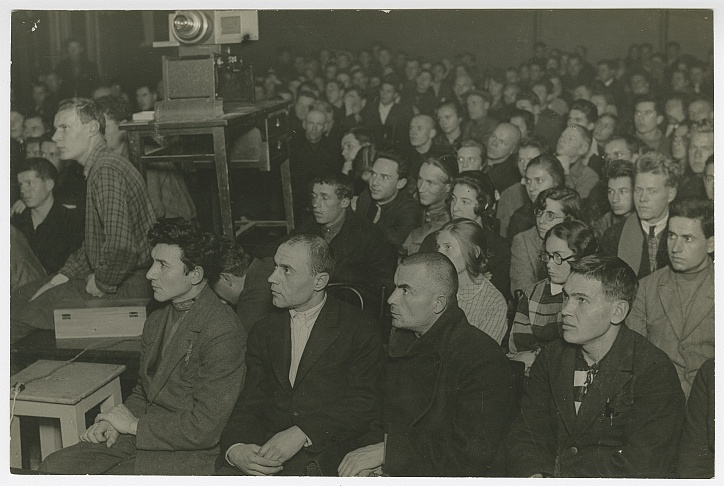
Unknown photographer, Audience listening to Hannes Meyer's lecture at WASI, 1930, Bauhaus-Universität Weimar, Archiv der Moderne.
As he already started doing in Germany, Meyer enlisted new Soviet supporters—along with their ideas and methods—into his struggle for the lost paradise.5 At one meeting he gathered ex-VKhUTEMAS students, now dispersed at institutes for textile, architecture, wood design, etc., and members of the competing AKhRR and October art groups, both popular among the youth. A resolution was published in the magazine Art into Masses, edited by the AKhRR:
“the destruction of the Bauhaus is an action of the white terror, that the fascistic capitalist Germany applies more and more often against the growing revolutionary movement of the working class, against (the) revolutionary intelligentsia that rises to fight against fascism and socio-fascism along with the working class. (…) The destruction of the Bauhaus, then, will only strengthen the struggle for ideas and methods that had been pushed forward by the Bauhaus under the leadership of Hannes Meyer.”6
There was a certain contradiction between such radical statements and the reality of the Meyer Bauhaus, which the exhibition demonstrated on a small scale. The reality of Meyer’s Bauhaus included Wassily Kandinsky’s classes as one “pole” of its program, but the “Red Bauhaus” fiercely rejected its bourgeois nature. The same VASI gathering also resolved to demand the Tretyakov Gallery remove paintings by the “white emigrant” Kandinsky, because he had assisted in the plot of the “socio-fascists.”7 In this contradiction lies a key motivation in organizing a Bauhaus exhibition that would fit Meyer’s agenda more precisely.
This idea of the exhibition was supported (or perhaps even suggested) by the by the VOKS, the All-Union Society for Cultural Relations with Foreign Countries. Established in 1925, this quasi-public organization was in fact a cultural diplomacy agency whose purpose was to control contacts between Soviet organizations and citizens with the outside world in order to cultivate a positive image of the USSR abroad.8 One of the VOKS’s duties was to welcome renowned visitors, and Hannes Meyer’s arrival in the fall of 1930 was thus the occasion for an official reception.9 It must be through Meyer’s prior communication with the VOKS that the decision was taken to demonstrate the ideologically “proper” Bauhaus with an exhibition at the Moscow State Museum of Modern Western Art (GMNZI). This museum habitually held exhibitions dedicated to foreign USSR sympathizers—organized through VOKS—such as Rabindranath Tagore (1930) and artists of the John Reed Club (1931). They were shown next to the museum’s permanent display of paintings by French impressionists, post-impressionists and cubists from the nationalized collections of Sergei Schchukin and Ivan Morozov.10
As the GMNZI’s records show, the exhibition Bauhaus Dessau: Period of Hannes Meyer’s directorship, 1928–1930 was by February 1931 already ready to receive the Moscow public.11 That indicates it was prepared by Hannes Meyer alone, or perhaps with the assistance of Béla Scheffler, who possessed more political experience. One thing is certain: no other Bauhäusler was yet around to influence its conception.
As Meyer declared in his introduction to the catalogue12: “The actual exhibition illustrates the third period of the Bauhaus movement, when an attempt was undertaken to turn this institute into the “Red Bauhaus”—the Marxist architectural school.”13 Further, he claimed he had tried “to introduce sociological methods rather than artistic (ones),”14 and that “this change was achieved with a group of students close to the KPD (Kommunistische Partei Deutschlands) in spite of the secret opposition of professors and art historians.”15

Unknown photographer, Bauhaus pop-up exhibition The destroyed Bauhaus at WASI, Moscow 1930, Bauhaus-Universität Weimar, Archiv der Moderne.
Meyer had to select works that would support these ambitious statements. The organization of the one-room display can be reconstructed with the help of photographs documenting three out of the exhibition’s four walls, the accompanying catalogue16 and a list of prior exhibits composed by GMNZI employees.17 My overview repeats some observations made by the architect Philipp Tolziner, whose thorough research undertaken in the 1970s remains unpublished.18
As the photographs show, the name of the exhibition was written in Russian over the entrance door—as Tolziner argues, by Meyer himself.19 In lieu of a curator’s introduction, a catalogue hung by a cord in the entryway. The exhibits themselves were mounted on fifty plywood panels, marked with the inscription “Bauhaus” and a catalogue number. These panels were hung in one or two rows. To the right of the door were placed six panels supporting photographic documentation of pieces made in the workshop for interior design, together with schemes for their assembly, and a second row of six panels containing numerous examples of graphic design commissioned by the KPD or other leftist political organizations with Bauhaus student membership (Max Gebhard, Albert Menzel and others). To the left of this hung four panels with newspaper articles about Hannes Meyer’s dismissal (Roter Student, AIZ (Arbeiter-Illustrierte-Zeitung), Pravda, etc.), Kostufra20 leaflets on the same subject and a selection from the RED magazine’s special edition on the Bauhaus, illustrated with documentation of Meyer’s Arbeiterbank project, works of the departments of Innenausbau, and examples from the Bauhaus weaving workshop and photography workshop. Two propaganda posters designed for the KPD and IAH21 by Bauhaus students Max Gebhard and Albert Mentzel hung above this grouping.
The photos of the Trade Union school in Bernau occupied a long wall opposite the entrance with 17 panels and an extra seven framed photographs hanging below it. On the wall to the right of the entrance hung nine or more panels showing documentation of student architectural projects, including the communal house by Philipp Tolziner and Tibor Weiner, a “school in Louny” by Antonin Urban and gallery-houses in Dessau-Törten. Examples of the Baulehre (Lothar Lang, Sonnendiagramm; Heinz Knaub, Der Garten; and others) apparently were placed on standing mounts below these panels. High above this group were placed two remarkable posters—presumably designed by Erich Borhert, who had lived in Moscow since his graduation from the Bauhaus—one with a red flag and the inscription “Bauhaus” and another illustrated with a hammer and sickle and the text “Long Live Soviet Germany” written in Russian.

Unknown photographer, Bauhaus pop-up exhibition The destroyed Bauhaus at WASI, 1930, Bauhaus-Universität Weimar, Archiv der Moderne.
Another wall with a window contained panels of “amateur photographs,” showing life at the Bauhaus. It is hard to distinguish what they depict exactly, but likely among them was a portrait of Meyer’s architecture student and lover Lotte Beese (sogar die lotte hängt dort unter den fotos an der wand (even Lotte hangs there under the photos on the wall)22), as well as photographs by Lony Neumann.23
At the center of the gallery stood a glass vitrine containing examples from the Bauhaus weaving workshop—20 out 37 by Lena Bergner, a Bauhaus graduate who also emigrated to Russia, probably taking these pieces with her. Two sample-albums with Bauhaus wallpaper and a catalogue were placed on a small table beside it, with chairs provided for visitors to sit in while looking through them.
To sum up: Hannes Meyer did his best in his choice of exhibits to illustrate the key words of his introduction, in which he described the Bauhaus as a Marxist architectural school that succeeded in actual production (wallpapers, textile). The Bauhaus’s wholist ambitions with its different “poles” (the vorkurs, theater, commercial advertising and painting) included in the Bauhaus Wanderschau of 1929–30, or in the Moscow show das zerstörte Bauhaus, were completely absent.
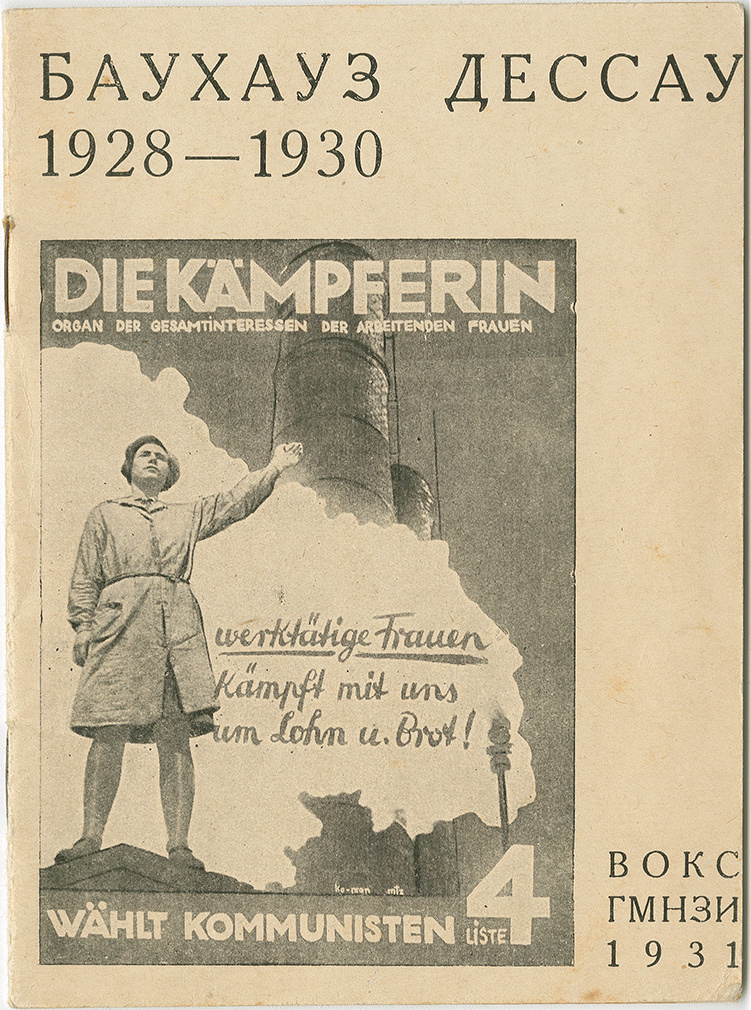
Hannes Meyer, Cover of the exhibition catalogue Bauhaus Dessau. Period of Hannes Meyer’s Directorship, 1928–1930, Moscow 1931, Bauhaus-Universiät Weimar, Archiv der Moderne.
Philipp Tolziner, who carefully traced the origins and authorship of each work in the Bauhaus Dessau show in his 1970s research, concluded that none of the communist prints occupying a significant place in the exhibition’s schema were official Bauhaus productions. The “real” Bauhaus products, in fact, were few. Tolziner’s tone approaches irritation when writing about his and Tibor Weiner’s design, Wohnen im Sozialismus, enlarged photocopies of which were placed on the Baulehre wall:
“We worked on this project not only in isolation from the official institute, but in contrast to its management, which took the view, as we were convinced and also realized, that there was no room for party-political activity at the Bauhaus. ... Therefore, we consider the use of the ‘communal dwelling house’ project to illustrate the political direction of an official “unified” Bauhaus led by its management to be contradictory to the facts.”24
According to Tolziner’s survey, only six out of 34 architects and art historians in Moscow could remember this exhibition, although they could recall other 1930s exhibitions of Western art, as well as lectures given by German architects.25 The oblivion to which Meyer’s show has been consigned, he believed, occurred because it did not reflect the Bauhaus as it really was and as it was understood by its Soviet contemporaries, the former VKhUTEMAS students. Further hypotheses to explain this unpopularity could undoubtedly be added.
As soon as the assembly of the exhibition materials was completed in February 1931, the VOKS turned to Arkady Mordvinov, an active member of the VOPRA (the All-Union Society of Proletarian Architects),26 a militant group of “proletarian architects,” to write an introduction for the exhibition. At the time, this group of young actors playing at cultural revolution played a prominent role within Moscow’s various architectural debates, condemning Constructivism as a style of the Western bourgeoisie. Hannes Meyer and Béla Scheffler applied to join this association in December 193027 and were admitted in February. This step is not so astonishing if we take into consideration Meyer’s rejection of the modernist “style,” and his search in his theoretical work of 1929-1930 for an ecologically, psychologically and culturally conditioned style of architecture.28 Mordvinov was the right person to ask for an article on the “Red Bauhaus.” He was amply capable of providing the Dessau exhibition with a necessary ideological sharpness:
“(…) the material for the exhibition is ready but its opening is delayed until the publication of the catalogue, which we regard as a political issue because of the destruction of the Bauhaus.”29
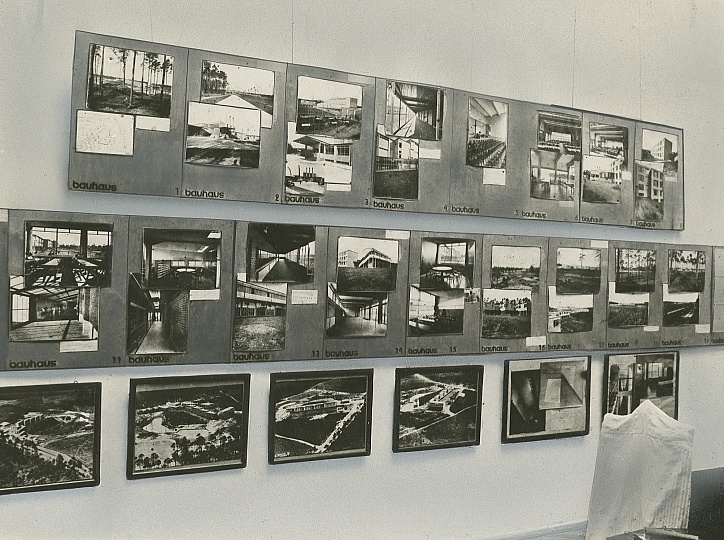
Exhibition Bauhaus Dessau: Period of Hannes Meyer’s Directorship, 1928–1930 at the Moscow State Museum of Modern Western Art (GMNZI), 1931, Bauhaus-Universität Weimar, Archiv der Moderne.
It was not until June, however, that the catalogue was finally completed, with the result that the exhibition could not open until July. Such an organizational failure was not exceptional in the Soviet Union of the 1930s, but in this case the delay was a serious misfortune, for in the meantime the story had lost all its actuality, even for Meyer himself
“(The exhibition) is coming a little post festum now and I can barely get used to the stuff….”30
The same could be said for the viewing public. In April, Meyer gave another talk at the VASI, this time in the company of renowned Marxist art historian Ivan (János) Mácza: “Formalism, Constructivism, Functionalism at the Bauhaus (Dessau) and the meaning of Hannes Meyer’s school for us.”31 It was followed by a detailed report in the Brigade of Artists (Brigada Hudozhnikov) magazine, where once again was repeated the story of Meyer’s unfair dismissal, its consequences and “objective” reasons.32
This fatigue was best expressed in a critical review by the Bauhäuslerin Lou Scheper-Berkenkamp, who was in Moscow with her husband Hinnerk Scheper, professor of the mural workshop. Her essay appeared in a Moscow German-language newspaper where she worked for a time, the Moskauer Rundschau:
“This exhibition is too personal and lacks objectivity—and the ‘VOKS,’ which wants to explain the lack of art in this context through the Bauhaus house material of the struggle (not only for art!), but let’s say for the artist as a symptomatic phenomenon of this struggle, is guilty of this to a great extent. A struggle that ended with the relocation of the active communist groups at the Bauhaus to Moscow, which at that time was interesting and topical in its details, now, here, where the problems that beset the Bauhaus are not present at all (but only the necessity to take from the West its best), the exhibition has no meaning at all anymore and appears uninteresting. It is the work that is interesting.”33

Unknown photographer, Exhibition Bauhaus Dessau: Period of Hannes Meyer’s Directorship, 1928–1930 at Moscow State Museum of Modern Western Art (GMNZI), 1931, Bauhaus-Archiv Berlin.
Scheper-Berkenkamp’s reference to the VOKS and how they treat art (artists) as a symptom of political or economic processes opens up another possible analytical angle for our understanding of the Bauhaus exhibition. Indeed, such “sociological” exhibitions were the latest thing in the Moscow art scene—as she admits in the very same review. Scheper-Berkenkamp also wrote positively of a recently opened permanent display she had seen at the Tretyakov Gallery, which must be the Experimental Comprehensive Marxist Display: the Art of the 18th and early 19th Century34—an exhibition that grouped masterpieces from the Tretyakov’s collection under categories such as “art of the conservative-feudal era” and “art of the large-scale serf-owners”—about which she wrote the following: “a new compilation of images and contemporaneous life props from many eras, set in the frame of a comfortably readable schema of the past.”35
This exhibition was a consequence of a Soviet museum reform initiated by several young Marxist art historians, whose aim was to reorganize museum collections “in such a way as to reveal the class nature of objects from different eras, as well as to move from a display of things to display of socio-economic processes.”36 This was supposed to turn museums into places for educating the masses rather than pilgrimage destinations for art-lovers. Today, this initiative is best known for its exhibitions of avant-garde art that had yet occurred, such as the “Experimental Comprehensive Exhibition of the Art of the Capitalist Era” (curator Alexandr Fëdorov-Davidov, 1931–1932). This display also had labels, schemas and commentaries—in this context, explaining the Russian/Soviet avant-garde as an example of bourgeois art. As recent scholarship has noted, this method of exhibition-making made extremely contemporary art look historical.37 The same distancing effect can be felt in another previous experimental display at the GMNZI, The style of the Industrial Bourgeoisie (curated by Nina Javorskaja in 1930). Here, recent artworks were shown together with pieces of interior design and, by way of example, a model of Le Corbusier’s Tsentrosoyuz building in Moscow. This exhibition was still on view at the GMNZI when Bauhaus Dessau: Period of Hannes Meyer’s directorship… opened.
.jpg?w=964)
Opening of the exhibition Bauhaus Dessau: Period of Hannes Meyer’s Directorship, 1928–1930 at the Moscow State Museum of Modern Western Art (GMNZI), 1931, Bauhaus-Universität Weimar, Archiv der Moderne.
To some extent, the Hannes Meyer’s exhibition also historicized the Bauhaus. Although it did not include dramatic inscriptions or didactic statements within the display itself, explanatory texts could be found in the catalogue, which, as has been mentioned, was readily available. According to Meyer’s text, the Bauhaus history followed an “objective” socio-economic course, from individualist anarchy to bourgeois style to a failed attempt of socialism, and finally, “a fascist reaction.” He concluded:
“Our experience at the Bauhaus Dessau has shown that ‘the Red Bauhaus’ as a training center for socialist architecture is impossible under capitalist conditions.”38
The very idea of a negative retrospective is something different from either a promotional Wanderschau of the sort Meyer curated the previous year, or the exhibition Bauhaus 1919–1928, organized in 1938 by Bauhaus émigrés Herbert Bayer, Ise and Walter Gropius at the Museum of Modern Art in New York. Unlike the latter, Mayer’s 1931 show did not promote the “spread of the Bauhaus idea”39 since, following his logic, it had been revealed as corrupt.
Most illustrative in this regard are the catalogue covers. The cover for the MOMA catalogue, designed by Herbert Bayer, is an exemplary Bauhaus design; the Moscow catalogue was probably produced by a VOKS designer, although curiously enough it stands out in comparison to the covers for other exhibitions organized by the VOKS and the GMNZI in the 1930–31 period— Bund der Deutschen Gebrauchsgraphiker (1930), The Artists of the John Reed Club (1931) or The Anti-Imperialist Exhibition (1931). Typical for the epoch, VOKS designers made an image or some other visual element an integral part of the cover design, while the Bauhaus exhibition catalogue used a black and white reproduction of another cover, designed by Bauhaus graduate Albert Mentzel for the magazine Die Kämpferin. Mentzel’s original cover had all the features of a 1920s propaganda poster—a strong red background, photomontage, the use of lettering of varying size. However, the exhibition catalogue has an extra title, “Bauhaus Dessau,” written above Mentzel’s graphic in large quasi-anti-Bauhaus serif typeface of the sort which became popular in Soviet typography later in the 1930s. This contrast, whether conscious or not, creates a visual distance between the Bauhaus—even in its “Red Bauhaus” version—and a Cyrillic layer, the present reality of the exhibition.

Opening of the exhibition Bauhaus Dessau: Period of Hannes Meyer’s Directorship, 1928–1930 at the Moscow State Museum of Modern Western Art (GMNZI), 1931, Bauhaus-Universität Weimar, Archiv der Moderne.
As a school, the Bauhaus was a closed chapter in history. Its achievements, as well as the achievements of all other epochs, could, however, be used for building socialism. On this point Lou Scheper’s critique appears to agree with that of Arkady Mordvinov, who in his introduction to the exhibition, published in a first issue of Sovetskaya Arkhitektura40 magazine, offers a selective reading of its legacy:
“What is valuable for us in the work of Hannes Meyer’s architectural school?
First: (its) scientific method of architectural design.... Second: rationalization in design and production. Everything is rationalized, even the blueprints are typified. And third: the system of architectural education. Bauhaus students of all years, together with a professor, are engaged in the designing and constructing of a building.”41
At the same time, Mordvinov’s article warns against what he considers a negative tendency in Meyer’s system: functionalism. He agrees with Meyer’s periodization of the “two Bauhauses” but finds both have their weak points: “… the school of Walter Gropius bears influences of cubo-Suprematism, formalism in art, but Hannes Meyer replaces art with science and technology.”42 The political leaflets were estimated as the only Bauhaus products exhibiting a truly proletarian nature.43 Their presence, however, was not enough to persuade the critics that Meyer’s Bauhaus was indeed revolutionary. The art critic David Arkin wrote a detailed account of the Bauhaus the following year with the telling title, “Esthetics of functionalism.” Quoting Meyer’s programmatic text “Bauhaus und gesellschaft,” which, of course, was not represented in the exhibition Arkin wrote:
“This poem about the Bauhaus proclaims the ‘integration into society’ of the Bauhaus work, the struggle against aesthetic formalism in the name of a 'harmonious work' and a purposeful determinacy of the formal world. While Meyer vigorously attacks the artistic templates and the banality of fashion and speaks out in favor of a transformation of the objects that determine the existence of society, he says nothing about the transformation of society itself. A functionalism immersed in the colors of the revolution proves to be at the service of a mere ‘harmonious development of our society.’”44
According to both authors, a positive outcome to the exhibition would only be possible if Meyer and the others were to overcome the Bauhaus, stop being functionalists and “remake themselves all (the way) through.”45
The exhibition Bauhaus Dessau: Period of Hannes Meyer’s directorship, 1928-1930 was neither a promotion for Bauhaus ideas nor a conventional retrospective. The curators wanted to present a revised version of Meyer’s Bauhaus, the “Red Bauhaus,” and thus they removed the load-bearing pillars of this structure—its theoretical foundations, its structure, the preliminary course, the production of its workshops, etc. The attempt to replace them with the political activity of a group of students using a newly acquired Marxist vocabulary made the final result unstable. The exhibition could probably have worked as a political manifestation of the sort which initially had proved so successful at the first Moscow meetings. But its delayed opening rendered it outdated. In the end, it could be easily attacked by the arguments of both Bauhaus-lovers (Lou Scheper-Berkenkamp, Philipp Tolziner later) and Bauhaus-detractors armed with ideological arguments (Mordvinov, Arkin). Hannes Meyer had agreed with the latter, who were his comrades in those years. Unlike the 1938 MOMA exhibition that became a springboard for the personal careers of the Bauhaus emigrants to the United States, the Bauhaus show in Moscow remained an ill-fated episode.
.jpg?w=964)
Unknown photographer, Exhibition Bauhaus Dessau: Period of Hannes Meyer’s Directorship, 1928–1930 at Moscow State Museum of Modern Western Art (GMNZI), 1931, Bauhaus-Universität Weimar, Archiv der Moderne.
The German version of this text "Nach dem Ball: Hannes Meyer stellt das Bauhaus in Moskau vor" will be published in October 2018 in: Thomas Flierl & Philipp Oswalt (eds.): Hannes Meyer nach dem Bauhaus. Im Streit der Deutungen, Spector Books, Leipzig 2018.
- 1 Gartman: “Kollektivnyi trud vozmozhen tolko vne kapitalizma” (Collective labor under capitalism is impossible), in: Pravda, August 11, 1930; Gartman: “Tvorchestvo v usloviyakh kapitalizma nemyslimo!” (Creative work under capitalism is impossible), in: Pravda, October 12, 1930.
- 2 VKhUTEMAS (the Higher Art and Technical Studios, 1920–1927) was the most important Soviet academy of art and design, founded after the revolution in Moscow. It possessed some similarities in its structure to the Bauhaus, such as the analytical basic courses. In 1927, VKhUTEMAS underwent a series of reforms and was renamed VKhUTEIN—the Higher Art and Technical Institute.
- 3 I wish to thank Dara Kiese for her help in identifying these images.
- 4 “Junge Menschen kommt ans Bauhaus” (Young People Come to the Bauhaus), publicity brochure for the Bauhaus, 1929. Collage on pp. 2–3.
- 5 Éva Forgács: “Between the Town and the Gown: On Hannes Meyer’s dismissal from the Bauhaus”, in: Journal of Design History, Vol. 23, No. 3, 2010, pp. 265–274.
- 6 Protest sovetskoy hudozhesvennoy obschestvennosti protiv razgroma Baukhauza. // Искусство в массы, 1930, No. 12, p. 31.
- 7 Ibid.
- 8 See on this topic: Michael David-Fox, Showcasing the Great Experiment. Cultural Diplomacy and Western visitors to the Soviet Union, 1921–1941, Oxford University Press, Oxford and New York 2011.
- 9 Letter from Hannes Meyer to Margret Mengel, October 28, 1930, Moscow. Getty Research Institute special collections: Lotte Stam-Beese correspondence with Hannes Meyer. I wish to thank Alla Vronskay for sharing this document.
- 10 The virtual reconstruction of the museum rooms is available at http://www.newestmuseum.ru/history/virtual/index.php?lang=en
- 11 The Department of Manuscripts of the Pushkin State Museum of Fine Arts, Holdings 13, Index 316, Sheet 14.
- 12 The whole English version of this Bauhaus catalogue is available on www.bauhaus-imaginista.org/articles/1893/the-moscow-bauhaus-exhibition-catalogue-1931
- 13 Hannes Meyer: Bauhauz Dessau. Period rukovodstva Gannes Maiera. 1928–1930 (Bauhaus Dessau: Period of Hannes Meyer’s Directorship, 1928–1930), Exhibition catalogue, Moscow, 1931, p. 5.
- 14 Ibid, p. 9.
- 15 Ibid, p.10.
- 16 Ibid, pp. 27–31.
- 17 The Department of Manuscripts of the Pushkin State Museum of Fine Arts, Holdings 13, Index 316, Sheet 14 (Cf. footnote 11).
- 18 Philipp Tolziner: “Die Moskauer Bauhausausstellung 1931. Ihre Bedeutung für die Geschichte des Bauhauses” (The Moscow Bauhaus Exhibition of 1931: Its significance for the history of the Bauhaus), manuscript, 1979, Bauhaus-Archiv Berlin, Tolziner Estate, Inventory No. II–15–3, pp. 1–31.
- 19 Ibid, p. 8.
- 20 Bauhaus Communist Student Union (Kommunistische Studentenfraktion).
- 21 Internationale Arbeiter-Hilfe: an adjunct of the Communist International initially formed to channel relief from international working-class organizations to parts of the Soviet Union stricken by famine. Later it would provide international support for striking workers, victims of anti-communist persecutions, etc.
- 22 Hannes Meyer to Lotte Beese, letter from July 16, 1931, Bauhaus-Archiv Berlin, Lotte Stam-Beese Collection, Portfolio 2.
- 23 The Department of Manuscripts of the Pushkin State Museum of Fine Arts, holdings 13, directory 316, Sheets 60f.
- 24 Tolziner: “Die Moskauer Bauhausausstellung 1931,” p. 21.
- 25 Ibid, p. 23.
- 26 On the relations between Hannes Meyer and the VOPRA, please see the catalogue of Wohnungsfrage (Haus der Kulturen der Welt): Tatiana Efrussi: “Hannes Meyer and the Concept of Proletarian Architecture,” in the section: Kollektiv für sozialistisches Bauen: Proletarische Bauausstellung, Spector Books, Berlin 2016.
- 27 Application for admission to VOPRA by Hannes Meyer and Béla Scheffler, Moscow, 27.12.1930, Deutsches Architektur Museum (DAM, Frankfurt/Main), Estate of Hannes Meyer, Inventory No. 164–002–009.
- 28 Cf. his notes for a lecture in Basel in 1929, in: DAM, Estate of Hannes Meyer, 164–202–001, reprinted as “Vorträge in Wien und Basel” (Lectures in Vienna and Basel), in: Hannes Meyer: bauen und gesellschaft, Verlag der Kunst, Dresden 1980, p. 54 ff.
- 29 Letter from Ešukov (exhibition department) to Mordvinov, 16.2.1931, State Archives of the Russian Federation, Stock 5283, Directory 11, Act 119, p. 34.
- 30 Letter from Hannes Meyer to Lotte Beese, 16.7.1931 (Cf. footnote 21).
- 31 Event planning for 31 April 1931 in the Department of Fine Arts of the Institute for Art and Literature of the Communist Academy. Archive of the Russian Academy of Sciences, Holdings 358, Index 1, File 107, Sheet 45 Rs.
- 32 А. Бассехес: “Разгром Баухауза” (A. Basseches: The Destruction of the Bauhaus), in: Brigada Chudošnikov (Die Künstler-Brigade) No. 4, 1931, p. 26f.
- 33 Lou Scheper: “Aus dem kritischen Notizbuch. Bemerkungen über Moskauer Museen und Ausstellungen” (From the Critic’s Notebook: Remarks about Moscow Museums and Exhibitions), in: Moskauer Rundschau, August 2, 1931.
- 34 Masha Chlenova: “On Display, Transformations of the Avant-Garde in Soviet Public Culture, 1928–1933,” Dissertation, Columbia University 2010, p. 134.
- 35 Scheper: “Aus dem kritischen Notizbuch” (Cf. footnote 32).
- 36 Протоколы заседаний Музейно-методического бюро при Главнауке, июнь – сентябрь 1931 (Minutes of the proceedings of the Museological-Methodical Office at Glavnauk (Head Office of Science at the People's Commissariat of Education), June - September 1931, quoted in: Masha Chlenova: “On Display ...,” (Cf. footnote 33, p. 134).
- 37 For a discussion of whether and to what extent this curatorial approach was “vulgar,” totalitarian or innovative, please see the dissertation chapter by Masha Chlenova & Maria Kokkori: “Exhibiting Malevich under Stalin,” in: Christina Lodder, Maria Kokkori & Maria Mileeva (eds.): Utopian Reality: Reconstructing Culture in Revolutionary Russia and Beyond. Russian History and Culture, Vol. 14, Slavic Review, Vol. 73, No. 4, Brill, Leiden 2013, pp. 133–153.
- 38 Meyer: Bauhaus Dessau, 1931 (Cf. footnote 12), p. 10.
- 39 Herbert Bayer, Walter Gropius & Ise Gropius (eds.): Bauhaus 1919–1928, Museum of Modern Art, New York 1938, p. 207.
- 40 А. Мордвинов: “Баухауз. К выставке в Москве” (Arkady Mordvinov: Bauhaus: To the Exhibition in Moscow), in: Советская Архитектура (Sovetskaja Architektura) No. 1/2, 1931, pp. 8–11.
- 41 А. Мордвинов: “Выставка Баухауз в Москве” (Arkady Mordvinov: The Bauhaus Exhibition in Moscow), in: Meyer: Bauhaus Dessau, 1931 (Cf. footnote 12, p. 23.
- 42 Ibid, p 16.
- 43 Ibid, p 19.
- 44 Давид Аркин: “Эстетика Функционализма. Архитектурная и художественно-промышленная деятельность Баухауза” (David Arkin: The Aesthetics of Functionalism. The Architectural and Artistic Production Activities of the Bauhaus), in: Бригада художников (The Artist Brigade) No. 2, 1932, p. 45.
- 45 Ibid, p. 50.















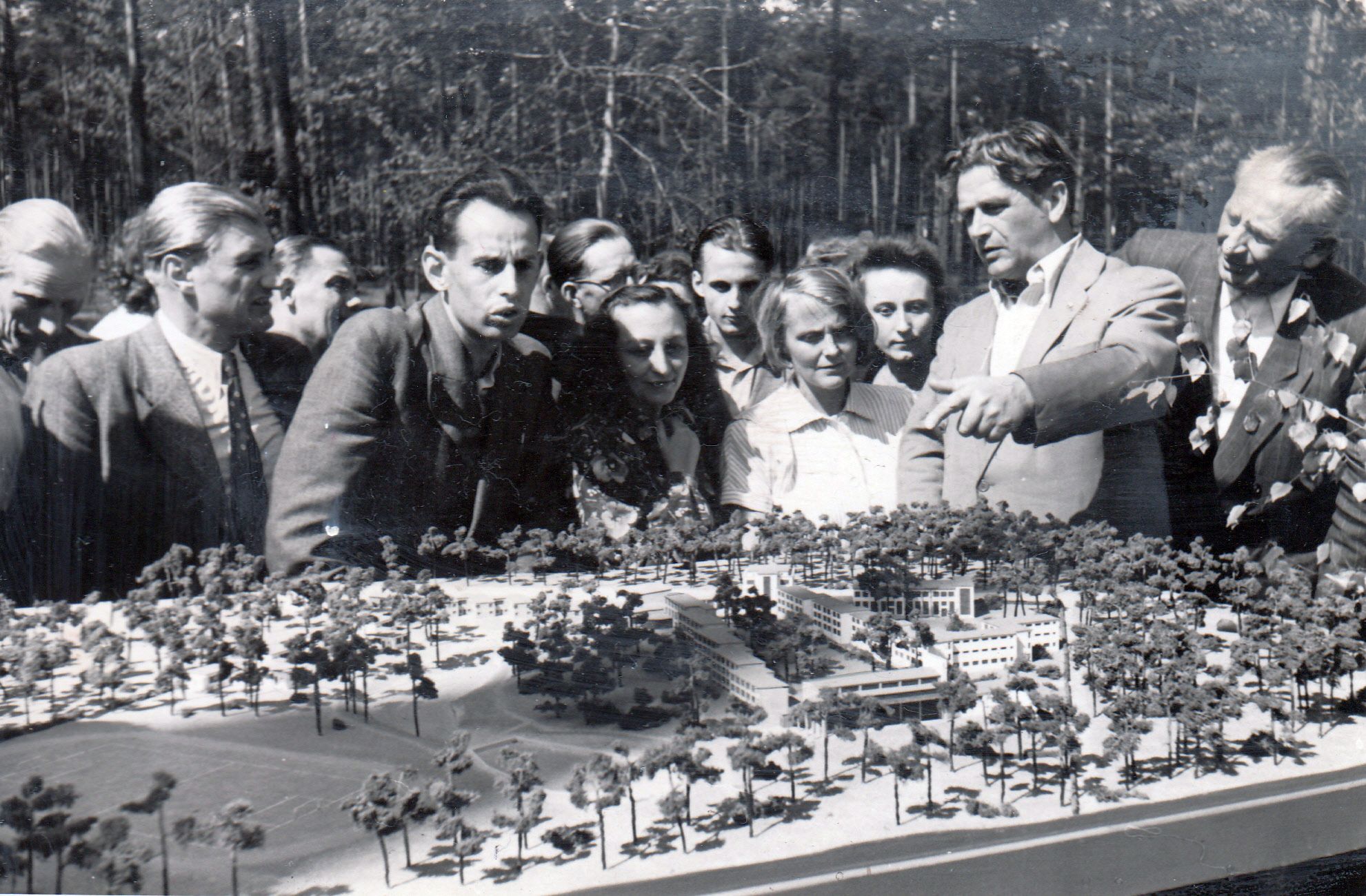







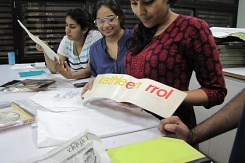









.jpg?w=245&h=163&c=1)

.jpg?w=245&h=163&c=1)








